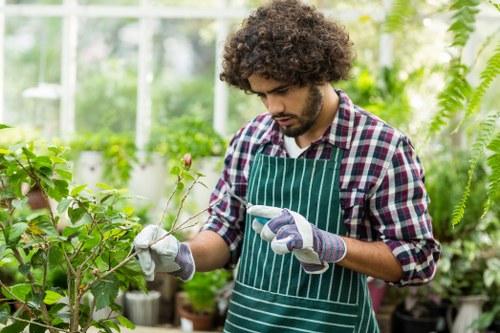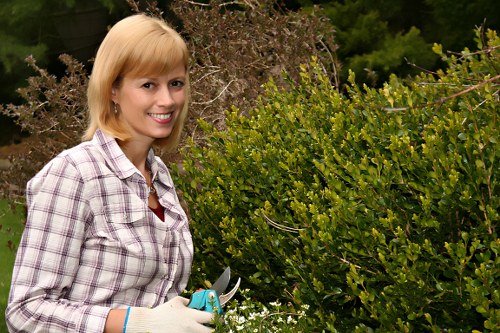Lawn Mowing Battersea: Your Ultimate Guide to a Perfect Lawn

Maintaining a beautiful lawn in Battersea doesn't have to be a daunting task. Whether you're a seasoned gardener or a newbie, understanding the essentials of lawn mowing will help you achieve a lush, green lawn that enhances the beauty of your home.
In this comprehensive guide, we'll explore the best practices for lawn mowing in Battersea, the tools you'll need, and tips to keep your grass healthy and vibrant throughout the year.
From choosing the right mower to scheduling your mowing sessions, we've got you covered. Let's dive into the world of lawn care and discover how to transform your outdoor space.
Why Lawn Mowing is Important

Lawn mowing is more than just keeping your grass short. Regular mowing promotes healthy grass growth, prevents weeds, and keeps your lawn looking neat and tidy. In Battersea, where the climate can influence grass health, consistent mowing is essential.
By maintaining the proper height of your grass, you allow sunlight and air to reach the soil, which helps your lawn resist pests and diseases. A well-mowed lawn also boosts your property's curb appeal, making it more attractive to visitors and potential buyers.
Moreover, mowing your lawn regularly can save you time and money in the long run by reducing the need for expensive treatments and extensive lawn repairs.
Choosing the Right Lawn Mower

Selecting the appropriate lawn mower is crucial for effective lawn maintenance. There are several types of mowers available, each suited to different lawn sizes and preferences.
Types of Lawn Mowers
- Push Mowers: Ideal for small to medium lawns, these mowers are affordable and easy to use.
- Self-Propelled Mowers: Great for larger lawns, they require less effort to push and maneuver.
- Electric Mowers: Environmentally friendly and quieter, perfect for eco-conscious homeowners.
- Gas-Powered Mowers: Provide more power and are suitable for tough, thick grass.
Consider the size of your lawn, the terrain, and your physical ability when choosing a mower. Investing in a high-quality mower ensures a clean cut and a healthier lawn.
How Often Should You Mow Your Lawn?

The frequency of mowing your lawn in Battersea depends on the growth rate of your grass, which varies with the seasons.
Seasonal Mowing Guidelines
- Spring: Grass grows quickly; mow once a week.
- Summer: Maintain a consistent mowing schedule, typically every 7-10 days.
- Autumn: As growth slows, mow every 2 weeks.
- Winter: Mowing can be reduced to once a month or as needed.
Always avoid cutting more than one-third of the grass blade length in a single mowing session to prevent stressing the grass.
Best Practices for Lawn Mowing

Adopting the right mowing techniques is essential for maintaining a healthy lawn. Here are some best practices to follow:
Mowing Techniques
- Keep Blades Sharp: Sharp blades ensure a clean cut, reducing the risk of disease.
- Mow at the Right Height: Different grasses require different mowing heights; research your grass type.
- Change Mowing Patterns: Vary your mowing direction each time to promote even growth.
- Remove Clippings: If clippings are too long, remove them to prevent matting.
- Avoid Mowing Wet Grass: Moist grass can clump and spread diseases.
Implementing these techniques will help your lawn stay healthy and vibrant all year round.
Maintaining Your Lawn Mower
Proper maintenance of your lawn mower extends its lifespan and ensures it performs optimally.
Maintenance Tips
- Regular Cleaning: Remove grass clippings and debris after each use.
- Check Oil Levels: For gas-powered mowers, regularly check and change the oil.
- Inspect Blades: Sharpen or replace blades as needed to maintain a clean cut.
- Store Properly: Keep your mower in a dry, sheltered place to prevent rust and damage.
Following a maintenance schedule can prevent unexpected breakdowns and keep your mower ready for every mowing session.
Eco-Friendly Lawn Mowing Practices
Embracing eco-friendly mowing practices not only benefits the environment but also promotes a healthier lawn.
Green Mowing Tips
- Use Electric Mowers: Reduce carbon emissions by opting for electric or battery-powered mowers.
- Mow Less: Taller grass shades the soil, reducing water evaporation and weed growth.
- Leaves Mulch: Allow grass clippings to decompose naturally, enriching the soil.
- Limit Chemical Use: Use organic fertilizers and pest control to minimize environmental impact.
Implementing these practices contributes to a sustainable and eco-friendly lawn care routine.
Local Lawn Mowing Services in Battersea
If you prefer professional help, Battersea offers a range of lawn mowing services tailored to your needs.
Choosing a Lawn Mowing Service
- Experience: Look for services with a proven track record in lawn care.
- Services Offered: Ensure they provide comprehensive mowing and maintenance options.
- Customer Reviews: Check feedback to gauge the quality of their work.
- Pricing: Compare rates to find a service that fits your budget.
Hiring a local service can save you time and ensure your lawn receives expert care.
Nearby Areas to Battersea for Lawn Mowing Services
Battersea is surrounded by several vibrant neighborhoods, each offering unique features and convenient access to lawn mowing services.
Top Nearby Areas
- Clapham Known for its parks and family-friendly atmosphere, Clapham residents can enjoy lush lawns with professional mowing services.
- Wandsworth Offers a mix of residential and green spaces, making lawn care essential for maintaining property beauty.
- Balham A bustling area with a strong community focus, Balham homeowners value reliable lawn mowing solutions.
- Westminster Central location with a variety of lawns requiring regular maintenance.
- Putney Close to the River Thames, Putney lawns benefit from expert mowing to complement scenic views.
- Earlsfield A peaceful neighborhood where well-kept lawns enhance the tranquil environment.
- Tapper Creek: Offers a mix of urban and green spaces, requiring diverse lawn care services.
- South Lambeth Residential area with a need for consistent lawn maintenance.
- Queens Road: Known for its vibrant community and beautiful gardens, Queens Road residents seek quality mowing services.
- Kensington High-end area where impeccable lawn care is a priority for maintaining property standards.
- Richmond Famous for its extensive parks, Richmond lawns require specialized mowing techniques.
- Shepherd's Bush: Busy area with a demand for efficient and reliable lawn mowing services.
Common Lawn Mowing Mistakes to Avoid
Even with the best intentions, certain mistakes can hinder your lawn's health. Being aware of these common pitfalls can help you maintain a vibrant and healthy lawn.
Avoid These Mowing Errors
- Mowing Too Short: Cutting grass too short weakens it and makes it susceptible to weeds and diseases.
- Ignoring Grass Health: Neglecting signs of stress or disease can lead to extensive lawn damage.
- Using Dull Blades: Dull mower blades tear the grass, causing browning and increasing vulnerability to pests.
- Mowing Inconsistent Patterns: Repeating the same mowing path can cause grass to lean and grow unevenly.
- Overlooking Edging: Failing to edge can make your lawn appear unkempt and disrupt the overall aesthetic.
By avoiding these mistakes, you ensure your lawn remains healthy, attractive, and resilient throughout the seasons.
The Benefits of Regular Lawn Mowing
Consistent lawn mowing offers numerous advantages beyond just appearance. Here are some key benefits:
Enhanced Lawn Health
- Promotes Even Growth: Regular mowing encourages uniform grass growth and density.
- Reduces Weeds: Shorter grass leaves less room for weeds to establish and thrive.
- Improves Soil Health: Mowing helps aerate the soil, allowing better water and nutrient absorption.
Increased Curb Appeal
- Attractive Property: A well-maintained lawn enhances the overall look of your home.
- Higher Property Value: Prospective buyers are more likely to value properties with beautiful lawns.
Environmental Benefits
- Carbon Sequestration: Healthy grass absorbs carbon dioxide, contributing to cleaner air.
- Temperature Regulation: Lawns help cool the surrounding environment by providing shade and releasing moisture.
Tools and Accessories for Lawn Mowing
Having the right tools can make lawn mowing more efficient and effective. Here are some essential accessories to consider:
Must-Have Lawn Mowing Tools
- Mower Blade Sharpeners: Keep your blades sharp for a clean cut.
- Lawn Bags: Collect grass clippings easily.
- Mulching Kits: Turn clippings into nutrient-rich mulch.
- Protective Gear: Wear gloves, safety glasses, and sturdy footwear for safety.
- Edge Trimmers: Achieve precise edges along walkways and flower beds.
Investing in these tools can enhance your mowing experience and contribute to a healthier lawn.
Seasonal Lawn Care Tips
Different seasons require varying approaches to lawn care. Adapting your mowing and maintenance routine accordingly ensures your lawn stays in top condition year-round.
Spring
- Begin regular mowing as grass starts to grow.
- Fertilize to promote strong growth.
- Control weeds early to prevent overgrowth.
Summer
- Mow more frequently to handle rapid growth.
- Water deeply but less often to encourage deep root development.
- Monitor for pests and diseases.
Autumn
- Gradually reduce mowing frequency as growth slows.
- Rake fallen leaves to prevent smothering the grass.
- Apply a fall fertilizer to prepare for winter.
Winter
- Minimize mowing as the grass enters dormancy.
- Remove debris to prevent mold and mildew.
- Plan for spring lawn care and maintenance.
Understanding Your Grass Type
Different grass types have unique care requirements. Identifying your grass type helps in tailoring your mowing and maintenance practices effectively.
Common Grass Types in Battersea
- Ryegrass: Fast-growing and hardy, ideal for quick green coverage.
- Bermuda Grass: Warm-season grass that thrives in sunny areas.
- Fescue: Cool-season grass known for its durability and shade tolerance.
- Kentucky Bluegrass: Popular for its rich color and fine texture.
Each grass type requires specific mowing heights, watering schedules, and fertilization plans. Understanding these needs ensures a healthy and attractive lawn.
Watering Your Lawn
Proper watering is essential for lawn health. Overwatering or underwatering can lead to problems such as root rot or dry, brittle grass.
Effective Watering Strategies
- Deep Watering: Encourage deep root growth by watering thoroughly but less frequently.
- Early Morning: Watering in the morning reduces evaporation and allows leaves to dry, preventing disease.
- Consistent Schedule: Maintain a regular watering routine tailored to your grass type and seasonal needs.
Using a sprinkler system or drip irrigation can help manage your lawn's watering needs efficiently.
Fertilizing Your Lawn
Fertilizing provides essential nutrients that promote grass growth and resilience. Proper fertilization schedules vary based on grass type and climate.
Fertilization Tips
- Soil Testing: Conduct a soil test to determine nutrient deficiencies.
- Choose the Right Fertilizer: Select a fertilizer that matches your lawn's needs.
- Apply Correctly: Follow application instructions to avoid over-fertilizing, which can harm your lawn.
- Seasonal Application: Fertilize during peak growth periods in spring and autumn.
Regular fertilization supports a green, healthy lawn that withstands wear and tear.
Dealing with Common Lawn Pests
Pests can cause significant damage to your lawn if not addressed promptly. Identifying and managing common lawn pests is crucial for maintaining grass health.
Common Lawn Pests in Battersea
- Grubs: Larvae that feed on grass roots, causing brown patches.
- Snails and Slugs: Feed on grass blades, leaving unsightly trails.
- Aphids: Suck sap from grass, weakening the plants.
- Armyworms: Devour grass foliage, leading to bald spots.
Implement integrated pest management (IPM) strategies, such as biological controls and targeted treatments, to effectively manage pests without harming the environment.
Enhancing Lawn Beauty with Edging and Trimming
Edging and trimming are essential for achieving a polished and well-maintained lawn. These practices define the boundaries of your lawn and keep it looking neat.
Edging Tips
- Define Boundaries: Use edging along walkways, driveways, and flower beds to create a clean separation.
- Use the Right Tools: Invest in quality edgers or trimmers for precise cuts.
- Regular Maintenance: Edge your lawn regularly to prevent overgrowth and maintain sharp lines.
Proper edging enhances the overall aesthetic of your lawn and makes mowing easier by preventing grass from encroaching into unwanted areas.
Mulching: Benefits and Techniques
Mulching involves leaving grass clippings on the lawn after mowing. This practice has several benefits for your lawn's health and the environment.
Advantages of Mulching
- Nutrient Recycling: Clippings decompose and release nutrients back into the soil.
- Moisture Retention: Mulch helps retain soil moisture, reducing the need for frequent watering.
- Weed Suppression: A layer of mulch inhibits weed growth by blocking sunlight.
To mulch effectively, ensure your mower blades are sharp and set to a higher cutting height to prevent excessive clippings from suffocating the grass.
Conclusion: Achieving a Stunning Lawn in Battersea
Maintaining a beautiful lawn in Battersea requires dedication, the right tools, and knowledge of best practices. By following the guidelines outlined in this article, you can achieve a lush, healthy lawn that enhances the beauty of your home and provides a serene outdoor space for relaxation and enjoyment.
Whether you choose to mow your lawn yourself or hire a professional service, consistency and attention to detail are key to long-term lawn health and aesthetics.
Embrace these lawn mowing tips and transform your Battersea lawn into a green oasis you can be proud of.
Frequently Asked Questions
1. How often should I mow my lawn in Battersea during the summer?
During the summer, it's recommended to mow your lawn once a week. However, this can vary based on grass growth rates and weather conditions. Ensure you don't cut more than one-third of the grass blade at a time.
2. What is the best time of day to mow the lawn?
The best time to mow your lawn is in the early morning. This allows the grass to dry before evening, reducing the risk of disease and ensuring a clean cut.
3. Can I let my grass grow longer during the winter?
Yes, allowing your grass to grow slightly longer during the winter helps insulate the soil and protect the grass roots from cold temperatures. Reduce mowing frequency as growth slows.
4. What type of lawn mower is best for a small Battersea garden?
For a small garden, a push mower or an electric mower is ideal. They are easy to maneuver, eco-friendly, and sufficient for maintaining smaller lawn areas.
5. How can I prevent weeds from growing in my lawn?
Regular mowing, proper fertilization, and watering practices can help prevent weeds. Additionally, applying a pre-emergent herbicide in the spring can inhibit weed seeds from germinating.